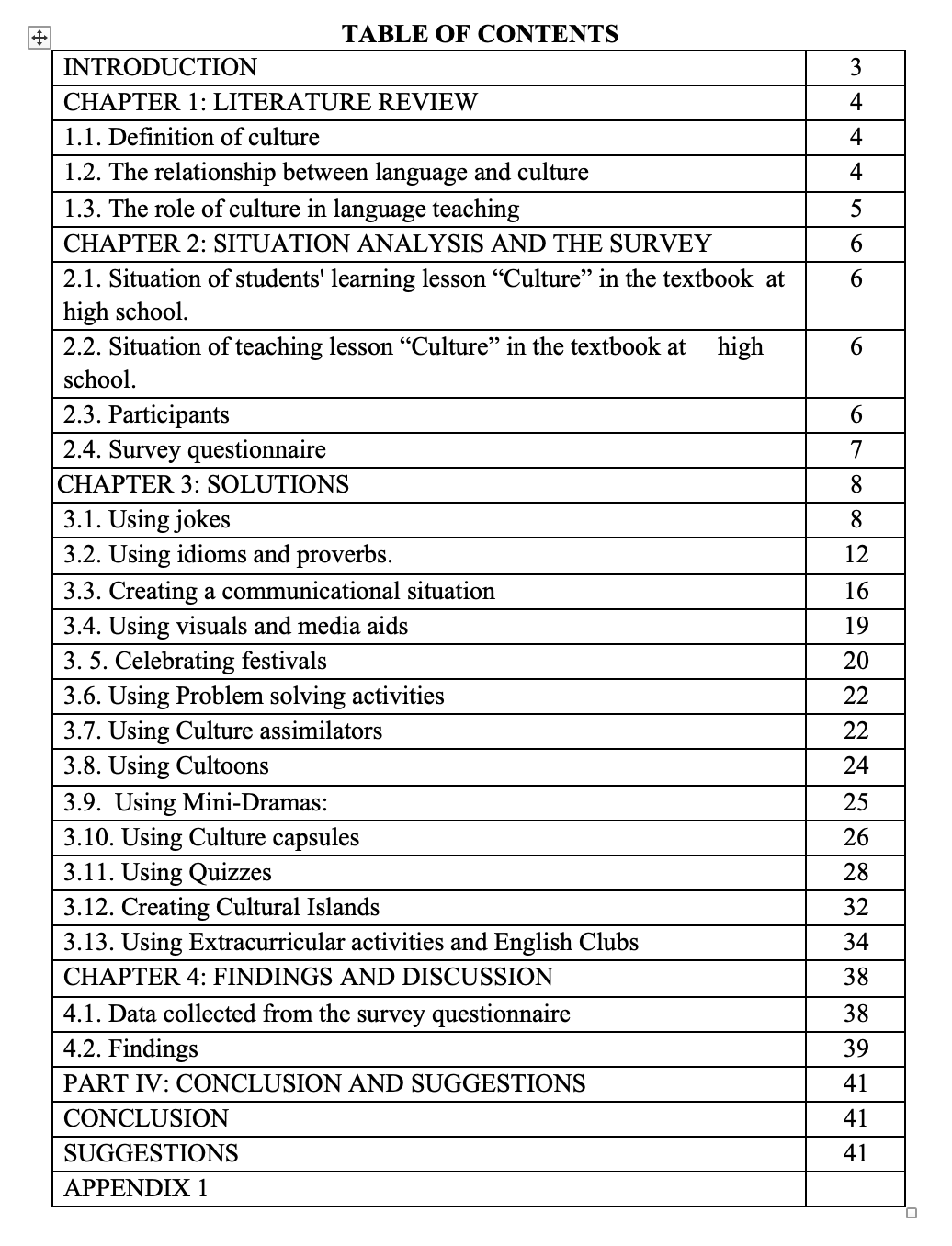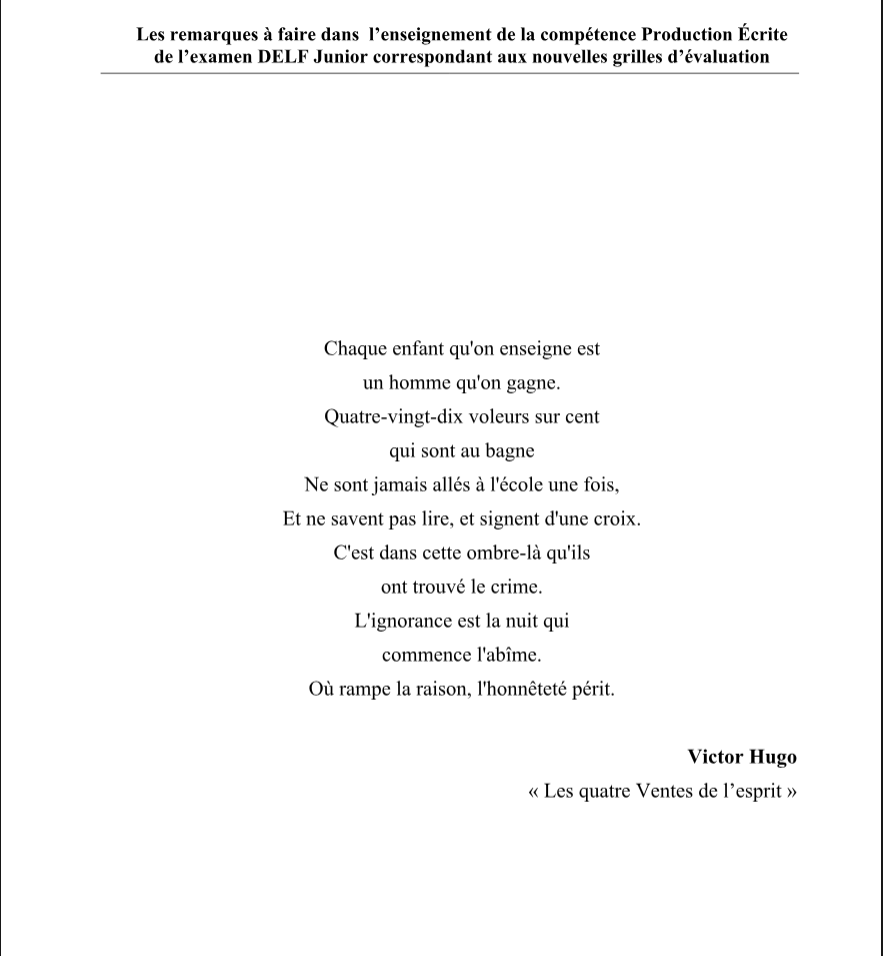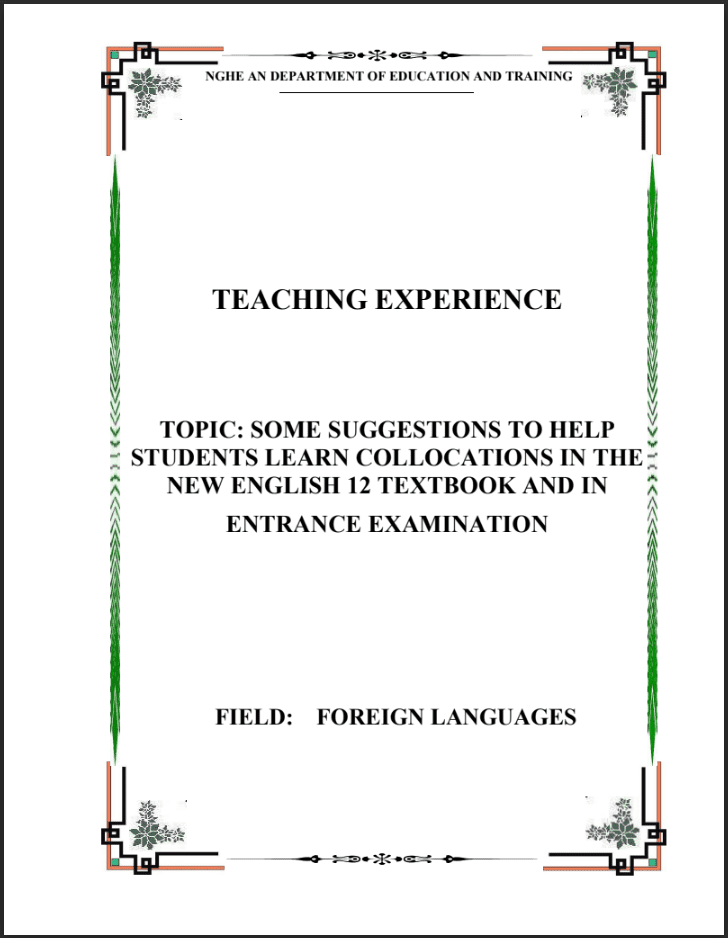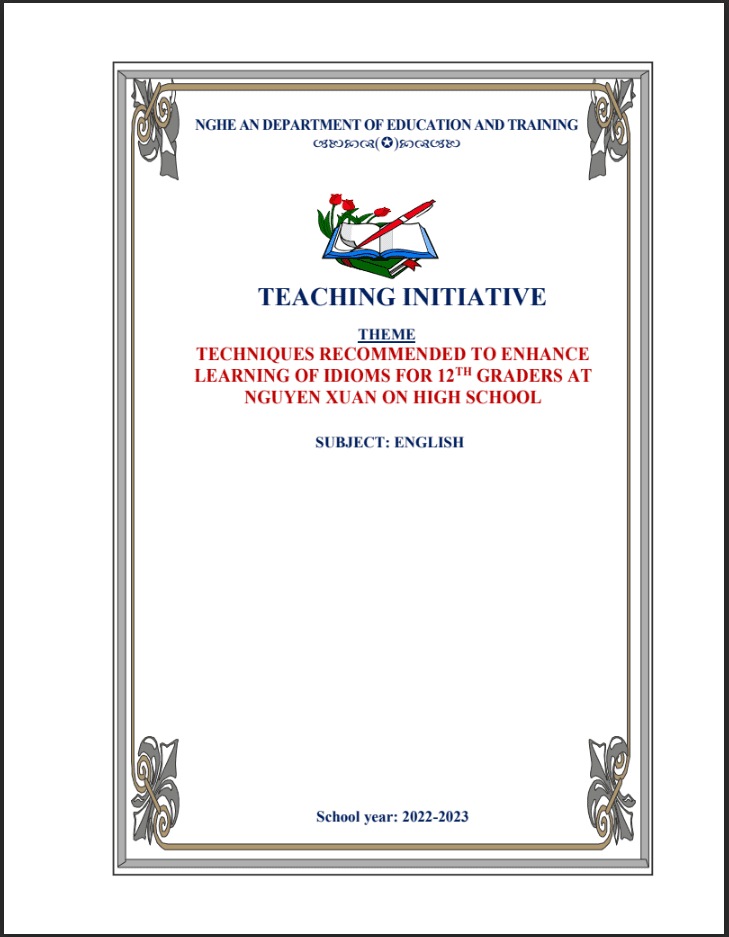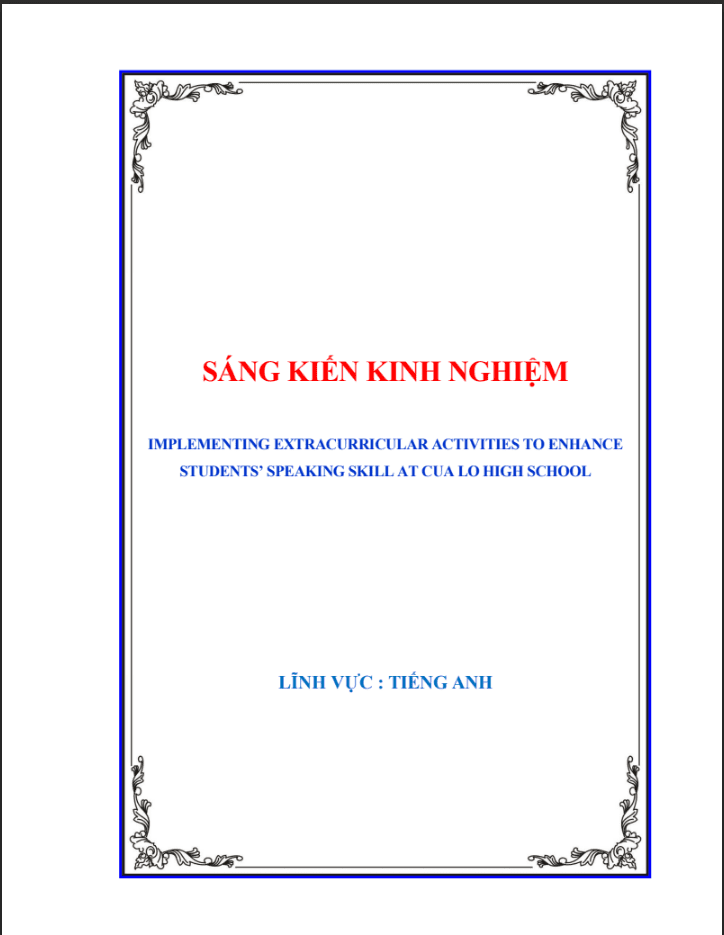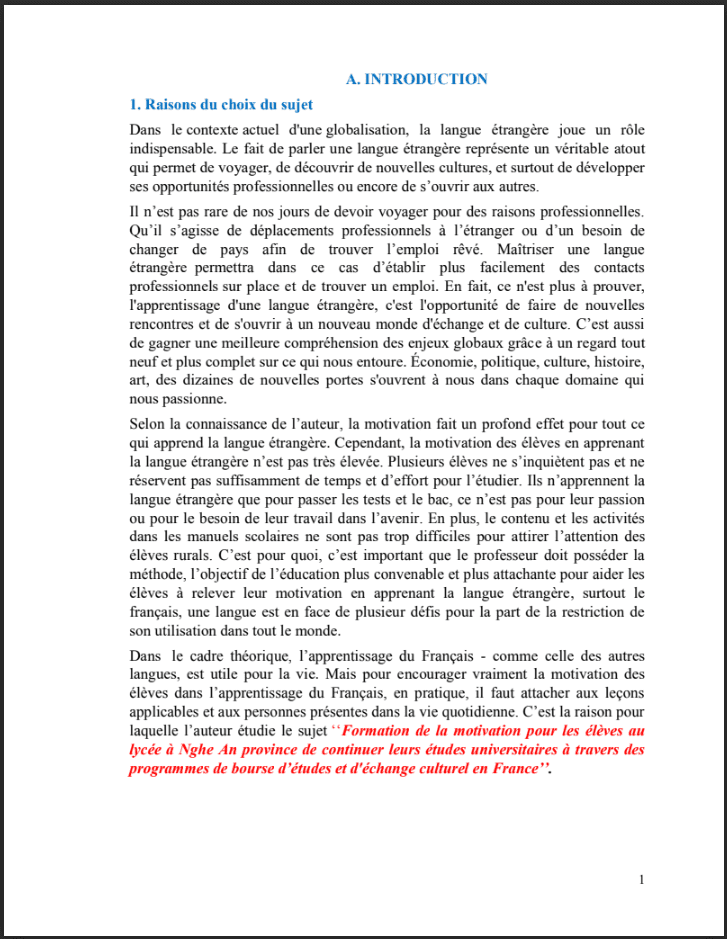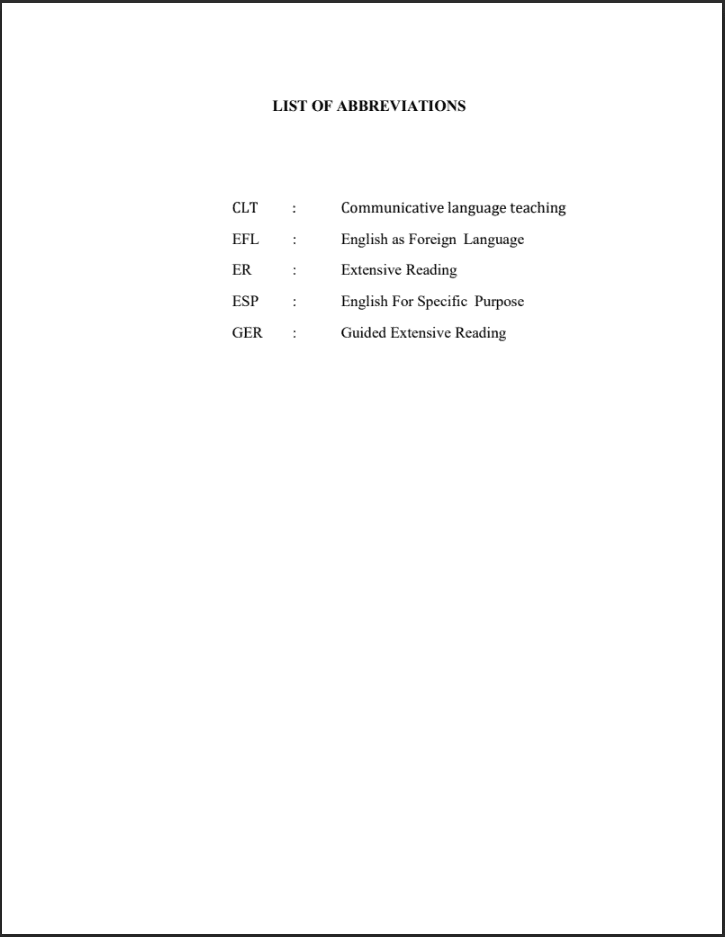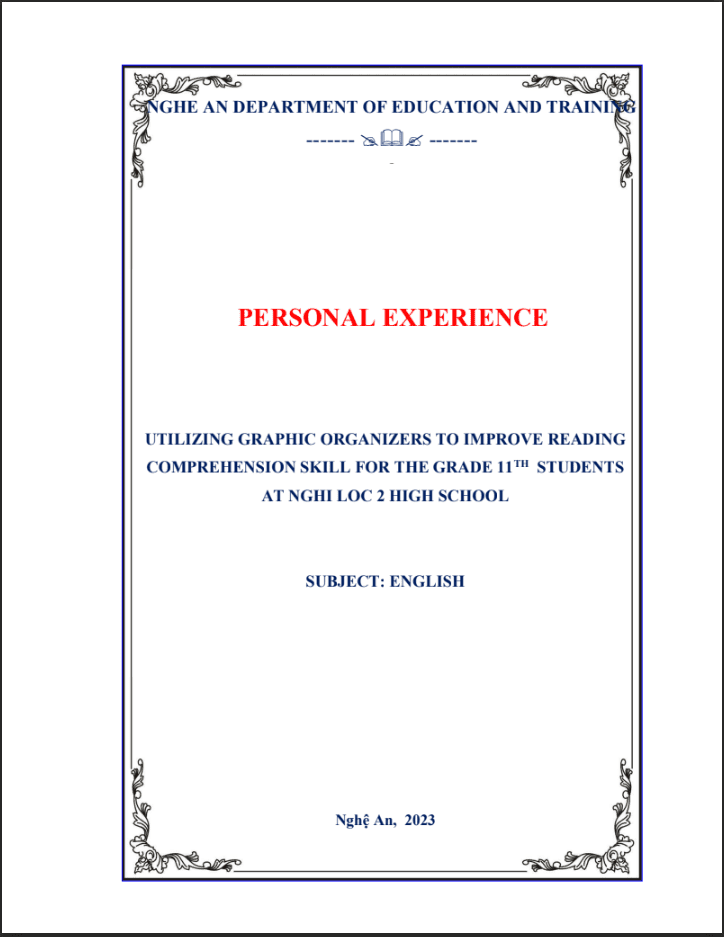SKKN Some techniques to teach the lesson Culture in the textbook to the students at Do Luong 2 upper secondary school
- Mã tài liệu: MP0029 Copy
| Môn: | Tiếng anh |
| Lớp: | 10, 11 |
| Bộ sách: | |
| Lượt xem: | 782 |
| Lượt tải: | 4 |
| Số trang: | 46 |
| Tác giả: | Bùi Thị Giang |
| Trình độ chuyên môn: | Thạc sĩ giáo dục |
| Đơn vị công tác: | THPT Quỳ Hợp |
| Năm viết: | 2021-2022 |
| Số trang: | 46 |
| Tác giả: | Bùi Thị Giang |
| Trình độ chuyên môn: | Thạc sĩ giáo dục |
| Đơn vị công tác: | THPT Quỳ Hợp |
| Năm viết: | 2021-2022 |
Sáng kiến kinh nghiệm “SKKN Some techniques to teach the lesson Culture in the textbook to the students at Do Luong 2 upper secondary school” triển khai gồm các biện pháp nổi bật sau:
3.1. Using jokes
3.2. Using idioms and proverbs.
3.3. Creating a communicational situation
3.4. Using visuals and media aids
3. 5. Celebrating festivals
3.6. Using Problem solving activities
3.7. Using Culture assimilators
3.8. Using Cultoons
3.9. Using Mini-Dramas:
3.10. Using Culture capsules
3.11. Using Quizzes
3.12. Creating Cultural Islands
3.13. Using Extracurricular activities and English Clubs
Mô tả sản phẩm
TABLE OF CONTENTS
| INTRODUCTION | 3 |
| CHAPTER 1: LITERATURE REVIEW | 4 |
| 1.1. Definition of culture | 4 |
| 1.2. The relationship between language and culture | 4 |
| 1.3. The role of culture in language teaching | 5 |
| CHAPTER 2: SITUATION ANALYSIS AND THE SURVEY | 6 |
| 2.1. Situation of students’ learning lesson “Culture” in the textbook at Do Luong 2 high school. | 6 |
| 2.2. Situation of teaching lesson “Culture” in the textbook at Do Luong 2 high school. | 6 |
| 2.3. Participants | 6 |
| 2.4. Survey questionnaire | 7 |
| CHAPTER 3: SOLUTIONS | 8 |
| 3.1. Using jokes | 8 |
| 3.2. Using idioms and proverbs. | 12 |
| 3.3. Creating a communicational situation | 16 |
| 3.4. Using visuals and media aids | 19 |
| 3. 5. Celebrating festivals | 20 |
| 3.6. Using Problem solving activities | 22 |
| 3.7. Using Culture assimilators | 22 |
| 3.8. Using Cultoons | 24 |
| 3.9. Using Mini-Dramas: | 25 |
| 3.10. Using Culture capsules | 26 |
| 3.11. Using Quizzes | 28 |
| 3.12. Creating Cultural Islands | 32 |
| 3.13. Using Extracurricular activities and English Clubs | 34 |
| CHAPTER 4: FINDINGS AND DISCUSSION | 38 |
| 4.1. Data collected from the survey questionnaire | 38 |
| 4.2. Findings | 39 |
| PART IV: CONCLUSION AND SUGGESTIONS | 41 |
| CONCLUSION | 41 |
| SUGGESTIONS | 41 |
| APPENDIX 1 |
INTRODUCTION
Language is a tool of human communication and people use language to communicate for many different purposes. On the other hand, every language has cultural elements, and often a country’s culture will be expressed through its language. Therefore, to be able to use a foreign language fluently, understanding the culture of the native country is extremely important. In particular, when English plays an essential role in globalization in all areas of life and we are in a period of strong integration with the world, understanding foreign cultures will help. Practical help makes communication easier and faster to achieve the purpose of communication.
However, in practice as well as in the learning process with native teachers, there are many cases where Vietnamese students make “cultural errors” when communicating. It is a mistake that learners make, which is said to be due to cultural differences between Vietnamese learners and foreign teachers. Therefore, besides teaching students about language knowledge such as vocabulary, sentence structure, grammar and skills of listening, speaking, reading and writing, teachers must aim to practice effective communication skills. especially the ability to communicate in different cultures. Foreign language teaching should not be separated from the interaction between the source and target language cultures. In other words, teaching a foreign language should be approached from a cross-cultural communication perspective.
In the new high school English program, culture is taught as a separate lesson. However, the lesson content is limited in cultural aspects and usually through a short reading and most students are not interested to discover new culture because they still have to perform the reading tasks. Therefore, in order for cultural knowledge to be conveyed in an interesting way, teachers have to choose different techniques.
Exploiting cultural factors in the process of teaching foreign languages in general and English in particular not only increases students’ interest in class, but also helps them improve their understanding of culture, people, customs and practices of many countries around the world, thereby forming a love of languages, the desire to discover and learn the beauty in the language and create a stronger learning motivation.
For such reasons, we boldly chose the issue “Some techniques to teach the lesson Culture in the textbook to the students at Do Luong 2 upper secondary school” as the main content of this study.
CHAPTER 1: LITERATURE REVIEW
1.1. Definition of culture
According to Henrichsen (1998) propounds the view that culture is language and language is culture. He suggests that to speak a language well, one has to be able to think in that language, and thought is extremely powerful. Language is the soul of the country and people who speak it. Language and culture are inextricably linked, and as such we might think about moving away from questions about the inclusion or exclusion of culture in foreign language curriculum, to issues of deliberate immersion versus non-deliberate exposure to it.
Similarly, Kramsch (1993:1) Culture in language learning is not an expendable fifth skill, tacked on, so to speak, to the teaching of speaking, listening, reading and writing. It is always in the background, right from day one, ready to unsettle the good language learners when they expect it least, making evident the limitations of their hard-won communicative competence, challenging their ability to make sense of the world around them
“Culture is deeply ingrained part of the very fiber of our being, but language –the means for communication among members of a culture- is the most visible and available expression of that culture. And so a person’s world view, self-identity, and systems of thinking, acting, feeling, and communicating can be disrupted by a change from one culture to another.” Brown(1994:170)
In a word, culture consists of patterns, explicit and implicit, of and for behavior acquired and transmitted by symbols, constituting the distinctive achievement of human groups, including their embodiments in artifacts; the essential core of culture consists of traditional ideas and especially their attached values; culture systems may, on the one hand, be considered as products of action, on the other hand, as conditioning influences upon further action.
1.2. The relationship between language and culture
The relationship between language and culture is a complex one. The two are intertwined. A particular language usually points out to a specific group of people. When you interact with another language, it means that you are also interacting with the culture that speaks the language. You cannot understand one’s culture without accessing its language directly.
When you learn a new language, it not only involves learning its alphabet, the word arrangement and the rules of grammar, but also learning about the specific society’s customs and behavior. When learning or teaching a language, it is important that the culture where the language belongs be referenced, because language is very much ingrained in the culture.
If culture is something that can be learned and communicated from generation to generation through human activity or through language communication, language is inevitably part of culture. Language is not only a part of culture but also a means through which culture is communicated. One will naturally express his culture through the language he uses: Every time we use language we express a cultural action. On the other hand, culture is also part of language, as language embodies the products, practices, prospects, communities, and people of a culture (Moran, 2001:7). Thus, language and culture are closely intertwined: “… they are so intertwined in a complex relationship that one cannot completely divide them without losing the meaning of culture or language”.a
TÀI LIỆU LIÊN QUAN
100.000 ₫
- 6
- 434
- 1
- [product_views]
100.000 ₫
- 2
- 507
- 2
- [product_views]
100.000 ₫
- 9
- 546
- 3
- [product_views]
100.000 ₫
- 4
- 409
- 4
- [product_views]
100.000 ₫
- 2
- 595
- 5
- [product_views]
100.000 ₫
- 0
- 538
- 6
- [product_views]
100.000 ₫
- 1
- 439
- 7
- [product_views]
100.000 ₫
- 5
- 578
- 8
- [product_views]
100.000 ₫
- 1
- 596
- 9
- [product_views]
100.000 ₫
- 3
- 509
- 10
- [product_views]

